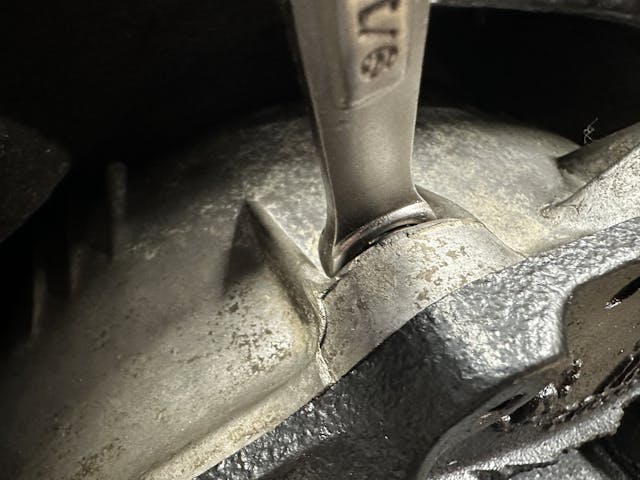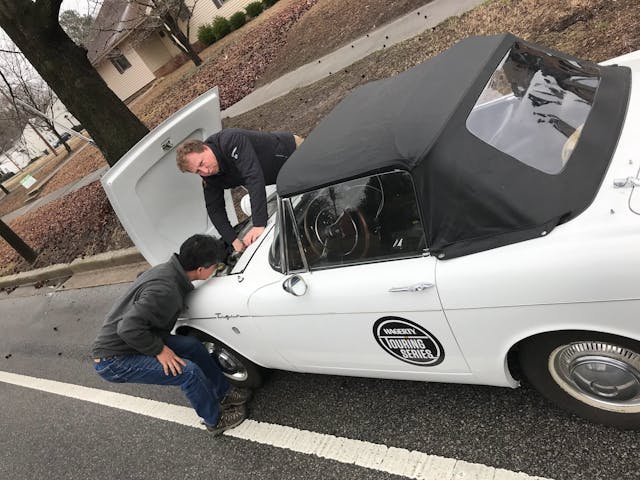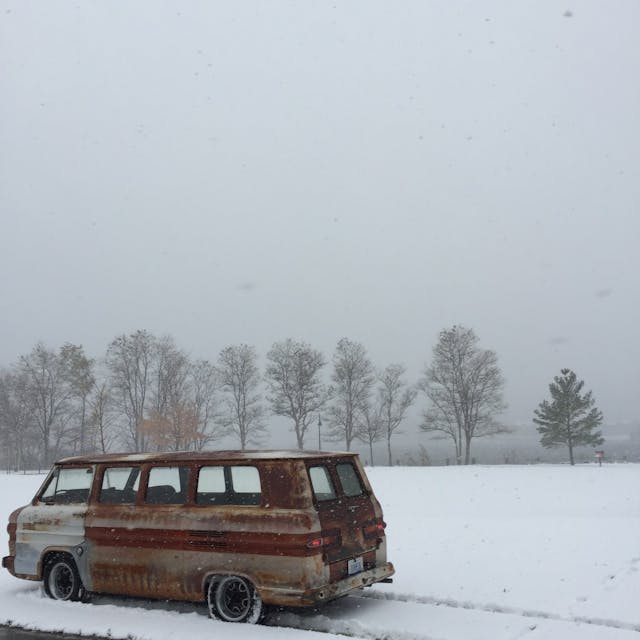Media | Articles
11 Rites of Passage for Every DIY Mechanic
Read all the books you want. Watch all the TV shows and YouTube mechanic videos that have ever been filmed. Sit and have a conversation with everyone who has turned a wrench. You still won’t be a mechanic, because practice and experience cannot be taught.
When younger enthusiasts recount certain adventures (or misadventures) to those with a few more years in the hobby, the seasoned folks will nod along. A mechanic’s rites of passage often need no explaining; by definition, these experiences have become universally accepted as ones that you must encounter and conquer to become proficient.
Which of these 11 rites of passage have you experienced, and which do you think changed you the most?
Rite of Passage #1: Roadside repair with makeshift parts
Whether on the road or in the shop, there comes a time when what you have is all you’ve got, and what you have just needs to work. Gaskets cut out of beer packaging, throttle cables made of shoestrings, or bailing wire on a part or piece that should be properly connected, but isn’t … If you understand a system well enough to engineer a functional fix on the fly, you truly understand how that system works.
Rite of Passage #2: Busted knuckles
You know the bolt is about to break free, so you give it a little extra oomph—and slam your hand into something. Usually, that something is heavy, rusty, or sharp … possibly, all three. Keep a record of your last tetanus shot handy, and know that we’ve all been there. Pulling towards yourself is often safer, except when it comes to cutting tools or other sharp implements.
Marketplace
Buy and sell classics with confidence
Rite of Passage #3: Trapped tools

The order of operations during disassembly and assembly is important—but you’ve got to pay attention to your tools, too. We’ve all been in situations when the excitement of a bolt coming loose makes us forget the limited space we’re working with, and suddenly our wrench is trapped between a bolt and a hard place.
Rite of Passage #4: Broken hardware

When a bolt chooses to Marie Antoinette itself, or threads stretch past the plasticity point and become unusable, progress can get tough. The fact of the matter is that rookies are more likely to break hardware, but there is a bit of a bell curve: As you tackle more and more projects, the quality of your work often rises; and then, as you gain confidence to handle the problems you now expect to encounter, the quality of your work tends to dip. Learning new methods for dealing with broken and stuck hardware is a never-ending quest for any wrench, green or seasoned.
Rite of Passage #5: Buying the shop manual
Just about everyone went through a phase when they felt as though they knew everything. Most advance out of such a state to understand that, even with everything they know, the shop manual knows more. Learning just how important and helpful a shop manual can be is often a freeing experience: Buying one is the first step to being self-sufficient because it allows you to solve problems without calling in experts or endlessly searching the web.
Rite of Passage #6: Disappearing parts
How else are you going to learn to organize your shop if you never experience the mildly panicked search for something you sat down right there? Everyone who ever gave you advice about doing DIY work probably told you to bag and tag parts and hardware, but most of us had to learn the benefits of organization the hard way to truly understand them.
Rite of Passage #7: Endless parts search

You saw that cool hunk of metal on the side of the road and just had to have it. Now you got it home and are excited to get to work and … Wait, there are no parts available for this? Sometimes the coolest models are the ones with the most problems and buying one that needs everything without realizing none of the parts exists is the gearhead’s version of falling in love with a crazy person: You often can’t give them what they need, and if you try, you’re going to be doing a lot of work (and probably spending a lot of money).
Rite of Passage #8: First rebuilt engine start-up
The thrum of a well-tuned engine is magnificent, but the stutter and cough of one chugging to life for the first time is even more enthralling. Was everything assembled correctly? Was anything forgotten? How is the combination of parts you chose going to work together? It all becomes clear with the first touch of the key. Weathering that storm of nerves is an experience unlike any other.
Rite of Passage #9: Ruined clothes
It was supposed to be a quick, clean job. Now that pair of jeans that used to be nice is stained with oil. (The situation is even worse if you’ve just ruined a pair of pants that your significant other specifically told you not to wear in the garage.) Typically when doing DIY work you dress to protect, not to impress. Hubris may protest, calling that an obvious truth, but the drawer of “work clothes” indicates we occasionally need a reminder.
Rite of Passage #10: Inclement weather moving in
Having a garage is a luxury that some of us take for granted. Most of us started by working on whatever we had wherever we could: Laying on our backs in gravel driveways, sitting cross-legged on the dirt of the back yard, or even leaning over core supports on the side of the street. If the sun was shining when you started work, your lack of protection from the elements becomes obvious as the clouds gather and the wind picks up. Being soaking wet, cold, and/or dirty while trying to assemble or diagnose your car is not fun, but we all must experience this misery to truly appreciate mild weather and good shelter.
Rite of Passage #11: Fixing what is not broken
The excitement to work on a project is sometimes so great that it must be satiated—even when there is work that needs to be done. I personally recall my father giving me the “if it ain’t broke, don’t fix it” speech while in my early teens; I had just made a mess of the garage floor taking apart something that had worked when I started and, more than likely, would never work correctly again. Poor thing.
Do you have to go through all of these to be a decent mechanic? Of course not, but many of us have experienced most, if not all, of these and more. Think we missed a rite of passage that changed you? Let us know about it in the comments below.
***
Check out the Hagerty Media homepage so you don’t miss a single story, or better yet, bookmark it. To get our best stories delivered right to your inbox, subscribe to our newsletters.














all but the engine rebuild
Finding out how much you don’t know.
Like a special tool (which might not be made anymore) is needed to disassembled something.
And how something simple can send you down a rabbit hole. You get something apart, only to find many more parts need to be replaced or you will be back doing it all again. This usually happens when you want to get it done in an evening, then the parts store is closed. Next morning you go to get the parts, and some aren’t in stock.
Learning which friends to trust to ‘help’ you. Could be they know less than you and you offer them a beer as they are helping. Beer is to toast a completed repair.
Roadside repair – once had a friend who had a broken motor mount. Instead of fixing it, he cruised around with an extra distributor cap. When he accelerated a bit too hard, you’d coast to the side of the road to swap it in for the broken one.
A big learning curve – figuring out when you have to take out extra parts and the job will go much easier. Something like an alternator on an early 2000’s Cadillac comes to mind. Liquid cooled and buried. My daughter had a friend who was a mechanic, started the job in our yard. Got it loose, left, not to be seen again. After a couple weeks, it became my problem. Was able to do it, but my neighbor and I decided at one point junking the car was a better option.
#5 I’m STILL waiting for HELMINC to publish my 2020 Chevrolet Colorado shop manual…and it’s well over $475.00 USD !!!
#12 ‘While I’m in here’ – firing the parts cannon at my 1986 T.P.I. injectors change…
I’m only gonna pull that plenum ONCE… maybe.
After removing a part only to find it no longer available . Then chasing through junk yards to find a replacement
My rite of passage was figuring a way to put a full-size car hood back on by myself, it can be done. … Gary V.
I don’t claim to be a mechanic but over the years I have experienced every one of the things on your list. My senior year in high school, 1975, I rebuilt a 327 for my $400 rolling chassis ‘69 Camaro. I put less than $1,000 in the car and had it on the street in less than six weeks. The first time I went to start it, flames were shooting 12 inches high out of the carburetor, I had put the distributor in 180 degrees off! Same car, so excited to break it in, I forgot to tighten the lugs nuts on the left rear tire. Luckily I felt it shaking before the tire came off. I tightened up the two lug nuts that hadn’t come off and limped it home. Priceless memories!
Kenny
Learning exactly when to apply full torque on a seized nut – usually about 2 ft/lbs lighter than when you snapped it.
Learning to weld, then learning the welder you bought (el cheapo flux core only) really won’t weld body panel steel which on my Jeep is 22 or 24 gauge, i.e. paper. And learning that the foam they inject into rocker panels and quarter panels is EXTREMELY flammable. Then learning that there’s a product called “panel bond” that will let you glue on thin metal without intense heat. (Still keeping the welder)
Never use brake cleaner to clean an area to be welded!
I hear it can kill you!
Are those Oldsmobile Rallye wheels on the Greenbriar? They look great!
I have been a car guy my whole life but work and family have occupied most of my working life. Finally had pulled together enough scratch to purchase my dream car a 67 Mustang Convertible. It has been a 15 year family affair enjoying the car with shows, clubs and picnics. The car needs a little TLC at this point but I made a recent aquisition of a Base 70 Fastback. The fastback had been parked since 1984 so all the base level mechanical needed to be done. It was just in advance of Covid and I was grateful to have the project. It was a labor of love, and I was determined to not let any part of the project intimidate me … for a guy with limited mechanical experience. I was able to tackle it all, Fuel Tank replaced, fuel lines, brakes, brake lines, fuel pump, water pump etc. radiator rebuild, bearings front, axles and seals rear, rear diff fluid change, u joints replaced, cleaned every inch, repainted engine bay, rear axle. Pretty much all the work I had not done before, and I learned so much. I enjoyed every minute of the process. I had to secure numerous tools to aid in the process. 18 months to get the car running to find that there was sheared valve #1 cylinder forcing a rebuild of the engine. I did not tackle that but had that done by others. The car had been an unmolested 64000 mile time capsule to that point. I am searching for a new project … want to find a Karman GHIA as my next project. I encourage anyone with some time to push thru the mental barriers that may present themselves. If I can do it anyone can. The internet, you tube, and any print you can get your hands on that relates to your project is immensely informative and can get you thru. There were lots of challenges but as I said I refused to let the project intimidate me or any setback discourage me from progress. I enjoyed it so much, and my car has turned out amazing.
As a teenager I had a 1967 Volvo 122S. On one cold morning I could not get the car to start.
I took out the spark plugs and put them in my mom’s oven. With the “Hot” plugs, the car started. My mom bless her soul, probably wondered why her electric oven smelled of gas. (don’t try this at home)
Mistaking inch pounds for foot pounds.
Minor suggestions to the busted knuckle thing which I’ve done many times (4 Corvairs, several other Chevy’s, two Peugeots, a VW or two, several Fords, an International Pick-up… Yes, pull on the wrench or if you must push use an open hand versus a clenched fist, put a rag over the sharp spot, whack the wrench with a rubber mallet. I would say doing extensive work on French cars will teach you about trapped tools and having extreme patience once you overcome the abusive Frenchman in your head from the Monty Python movie.
“Of course we are French! Why do you think we have this odd ball engineering? Now go away or I will be forced to throw a Peugeot Supan flank drive wrench in your general direction!”
Simply, been there done that each and everyone of them. Seems like all who comment are in the club. Thanks for the look back as today I am no longer a Shade Tree Mechanic but still have Duck Tape, wire coat hanger and a dime in the trunk just in case.
My wife calls it “McGivering”…..following are my two best:
1) Wiring points together on the side of the highway on a 1978 Datson 240Z, using wire from a roadside shredded steel belt radial.
2) After driving over a log and having a branch rip the fuel line in half (don’t ask me why a Ford Taurus fuel line is so exposed on the underside of car), engine died, losing fuel: cut line and pinch it off to save fuel. Used windshield washing rubber line to splice. Drove out of mountains for over 60 miles. Glad it was a rental.